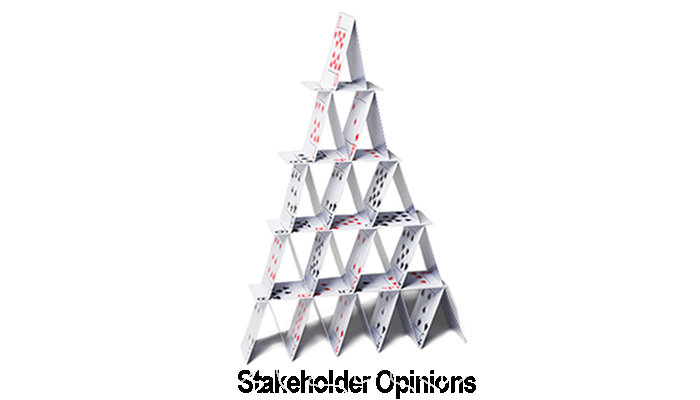
For millennia, man believed the Earth was flat.
Based on the visible horizon they could see.
And assumption that Gods were above the earth, looking down on it.
In the 20th century, quite unrelated, group decision-making evolved as an academic discipline.
Data Collection and Benchmarking emerged to provide decisions with their facts and figures.
Stakeholder Interviews and Analysis was created to understand the decision-maker’s opinions.
Identify the stakeholders.
Ask them each a set of questions.
Write down what they say.
Study the responses to observe themes and patterns.
Draw conclusions from the observations.
Use these to design their meeting agenda.
Facilitate the generation of a set of goals and enabling actions.
Implement.
The stakeholders arrive at the target destination as planned.
Though few do.
Very few get close to on-benefit, on-time, and on-cost.
Project management is a highly mature discipline.
Change management is a mature discipline.
So are the delayed actions, missed goals, and blown budgets just bad luck and incompetent execution?
Because the goals and objectives were right.
They couldn’t be the problem.
Could they?
Stakeholder Interviews and Analysis was also founded on a core underlying assumption.
Stakeholders are authorities.
What they say can be trusted.
When a stakeholder expresses an opinion in their interview, it is assumed they know best.
The other stakeholders would agree if presented with the opinion.
Wouldn’t they?
Over the past decade, hundreds of groups allowed us to evaluate their stakeholder’s opinions.
Fortune 50 leadership teams, government agencies, academia, NGOs, not-for-profits, global coalitions, and others across all walks of life.
Strategies, policies, process improvements, programs, business problems, transformations, changes, innovations, mergers, alliances, and other strategic topics.
Tens of thousands of executives, leaders, managers, consultants, process owners, staff, customers, suppliers, regulators, and policy makers.
Church leaders.
Foreign aid nurses in the Amazon.
Wall Street executives.
Hundreds of thousands of opinions.
We anonymously shared each stakeholder’s opinions with their peers.
And invited them to privately agree or disagree.
On average,
Groups agreed with only 17% of their peers’ opinions.
There was disagreement with 83% of them.
How can that be if those invited into the decision-making process are authorities and subject matter experts expressing what is correct?
What does this mean for the validity of the goals and actions that emanated from an analysis of opinions with 17% agreement and 83% disagreement?
Technically, until the interviewer reconciles the disagreement in that 83%, they are invalid inputs, not fit for use.
Quality-failed decision raw material.
The goals and actions are always rational and logical.
Usually compelling, too.
But inaccurate.
The group’s decision is a False Positive.
That if implemented perfectly, would take them to the wrong place.
But rarely can be implemented, because the 83% underlying disagreement was left unreconciled.
Everything was based upon an inaccurate portrayal of reality.
Even when augmented with collected data and benchmarks.
For the sample groups to create an accurate picture, we developed two analysis frames – GUBA and OIS.
On average, these identified 54% of the 83% of disagreed opinions as important enough that the stakeholders needed to reconcile them.
Of these, the groups validated 59% of these important disagreed opinions.
Those who disagreed switched to agree.
But they also invalidated 41% of those stakeholder opinions suffering peer disagreement that they deemed essential to making a strong decision.
When we reconciled the stakeholder’s anonymous reasoning, those who had agreed with the disputed opinion – including the opinion’s source stakeholder – switched to rejecting it.
All done anonymously, so no one lost face.
Around 600BCE, Pythagoras postulated the earth was a sphere.
Around 250BCE, Eratosthenes measured the earth’s circumference.
Around 150AD, Ptolemy described a round earth in his geocentric model.
Eventually, in the 15th century, Magellan and other venturers proved the earth was not flat by sailing out of sight over the horizon and returning to their port of departure weeks and months later.
In 1946, the U.S. military took the first photograph of Earth from space.
In 1972, the Apollo 17 astronauts took the iconic ‘Blue Marble’ photograph of Earth.
People across the globe have resigned the Flat Earth theory to history.
Except for a fringe community of Flat-Earthers who do not believe the data.
A set of validated stakeholder opinions yields a materially different set of goals and actions to those derived from a non-validated set.
We should respect stakeholders as leaders, managers, and subject matter experts.
However, the assumption that stakeholder opinions are sufficiently correct for interviewers to use them untested is invalid.
So, for group decision-making, we have resigned Stakeholder Interviews and Analysis to history.
This is Part 1 of a three-part series on Group Decision Strength.